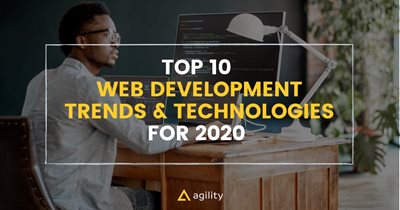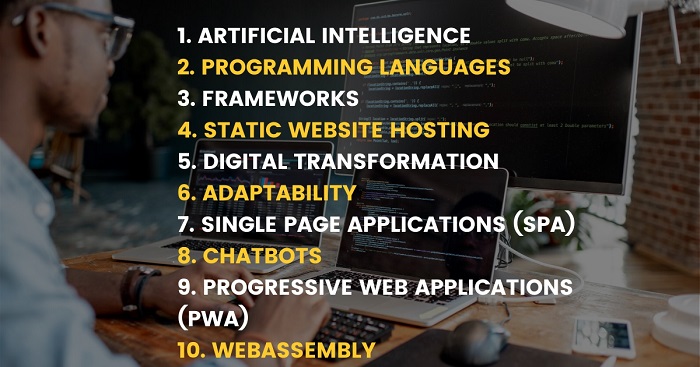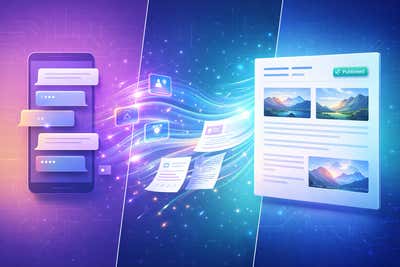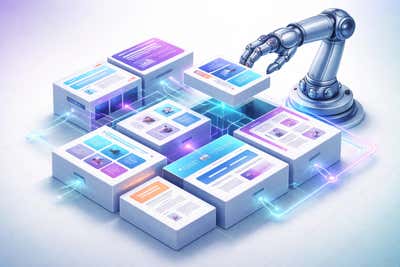Top 10 Web Development Trends & Technologies For 2020


Web developers work in environments that are continually evolving. They need to adapt to the shift of technologies and keep up with the changes that are constantly surrounding them. But, just like any other industry, it’s important to keep up with the most important trends and technologies that arise and avoid others that aren’t ready for primetime. Because of this, I decided to compile a list of the top 10 web development trends and technologies that will dominate in 2020 and beyond.

1. Artificial Intelligence
According to Gartner, artificial intelligence (AI) is forecast to reach $3.9 trillion in 2022. Many organizations are incorporating AI into their digital transformation strategy, and there's no sign of it slowing down. Recently, Babylon by TELUS Health created a free healthcare mobile app that allows you to check symptoms, consult with doctors and access your health records. Developed by a skilled team of doctors and scientists, the app transcends typical online health advice by combining artificial intelligence (AI) technology with real face-to-face consultations.
But, let's not forget about the brands who have already been using AI for several years and are reaping the rewards in terms of profits, brand reputation, and visibility, like Starbucks, for example. Starbucks uses a mobile app to drive personalized experiences to their customers. Now they are leveraging that data to improve their drive-thru experience too.
In this article by Microsoft, Starbucks explains how they're using data from their mobile app to improve their drive-thru experience. "Because the technology does not have the individual order histories for drive-thru customers that are available for mobile app customers, it will generate relevant drive-thru recommendations based on store transaction histories and more than 400 other store-level criteria. These recommendations will be offered proactively on a digital menu display from which customers can order. Eventually, customers will be able to explicitly opt into recommendations that are even more personalized" said Gerri Martin-Flickinger, EVP and CTO at Starbucks and added "we're meeting our customers where they are — whether in-store, in their car or on the go through the app — using machine learning and artificial intelligence to understand and anticipate their personal preferences."
There are a few ways you can leverage artificial intelligence into your web development initiatives going into 2020. You can use AI to help you analyze and understand the behaviour of visitors to your website – there are even pre-built tools such as Cognitive Services from Microsoft on the Azure Platform. You can then adjust your content-first approach or any other new initiatives based on the data you've gathered and analyzed.
2. Programming Languages
There are hundreds of computer programming languages to choose from. You don’t need to learn them all, though. There are few leaders you can focus on. Older languages such as C have newer derivatives in Java and C# with newer tooling and features that can help you be more productive and learn them faster.
For AI and machine learning applications, as well as web development, Python is becoming a standard language and is widely documented as it has been around for a long time.
JavaScript is, without a doubt, the unconditional basis for front-end development and is the most widely used programming language in the world for developing web applications. In fact, JavaScript is used on 95% of all websites. You need to be fluent in it, which means you need to know NPM (Node Package Manager) or Yarn. NPM or Yarn makes it easy for JavaScript developers to share and reuse code and makes it easy to update the code that you're sharing.
Also, Google's Golang continues to pick up steam. Golang is an open-source programming language supported by Google, and yes, you can even use it to build a website! Check it out if you haven't yet. You can also run a Go playground to test it out first.
3. Frameworks
JavaScript Frameworks
Learn a new framework, or double down on what you believe is the best one – that probably means React or Vue. React and Vue are no longer “new,” but there are a ton of new features and methodologies that have sprung up around these, such as React Hooks, and using Typescript, which is a more structured, object-oriented form of JavaScript.
You should also check out the frameworks that go on top of React and Vue for Static Site Generation or server-side rendering: Next.js for React, Nuxt for Vue. There is a brand new React-based framework for static site generation that is taking the web development world by storm called GatsbyJS. Agility CMS is a headless CMS and has recently released a source-plugin for GatsbyJS that allows you to get a website up and to run quickly using Agility CMS as your content management system for free.
CSS Libraries and Frameworks
Start looking at ways to jumpstart your front-end development with help from these CSS libraries. It will be a significant benefit to you in the long run. Bulma and Tailwinds are a great way to speed up your front-end design process as they provide lots of layout ideas and predefined component ideas.
Also, look at Bootstrap – it is a platform for building your website or web-based app. It might be a little too daunting to some but worth checking out. It's beneficial to become familiar with how it works as many existing web apps are based on Bootstrap.
Web Components
This is a relatively new technology that is moving fast and will potentially rewrite the way we think about reusable web technologies. Web Components are a set of web platform APIs that allow you to create new custom, reusable, encapsulated HTML tags to use in web pages and web apps. If you are familiar with building components in libraries like React or Angular, Web Components should feel similar.
4. Static Website Hosting (i.e. for JAMstack sites: Netlify)
Netlify is a static web host that is great for JAMstack sites. Netlify is a web hosting infrastructure and automation technology company based in San Francisco. What's cool is that JAMstack was initially brought to life by Netlify's Co-founder, Mathias Biilmann. Netlify provides next-generation web hosting and automation that's very affordable. They also offer web hosting infrastructure for JAMstack websites.
JAMstack was born out of a need for websites to be fast, primarily in terms of performance. Developers also found that it was much faster for them to develop with a JAmstack as well, which was a huge bonus. (Check out our Webinar here where we deployed a website Using Gatsby and Agility CMS in real-time)
5. Digital Transformation - moving away from Traditional CMS to Headless CMS
When it comes to making choices today, expectations are higher than ever. Digital transformation can come as a quick surprise, and if you aren't prepared for it, and it can be daunting. Why wait for it to happen? With a headless CMS, you get more benefits, then you would going with a traditional CMS, especially in terms of its content first delivery. You can use a headless CMS for a long time, and it can be integrated with multiple platforms through various devices and build custom or bespoke content. Headless CMS is becoming a mainstream way to deliver content. Organizations are moving away from Traditional CMSs.
6. Adaptability
Have you ever browsed a website on your mobile device that doesn’t look aesthetically pleasing or something is broken? Yeah, me too. I tend to navigate away from it and never revisit it. According to Statista, by 2022, mobile data traffic worldwide is expected to reach 77.5 exabytes per month at a compound annual growth rate of 46%.
This is why a headless CMS is a dream come true for developers. With a headless CMS, your website can adapt to every digital touchpoint, and your content can look aesthetically pleasing. Developers can continue to build websites or mobile applications using any programming language with their favourite tools, frameworks, and own development processes while still allowing full control over the application lifecycle without having to interfere with any CMS code.
7. Single Page Applications (SPA)
A single-page application is a web application or web site that interacts with the user by dynamically rewriting the current page rather than loading entire new pages from a server. This approach will avoid interrupting user interaction between consecutive pages. SPA spares visitors from difficult navigation and swirling menus and adapts to any device.
8. Chatbots
AI and omnichannel is used in the creation of chatbots. Chatbots are primarily used for customer service and in automating processes, specifically in marketing and analytics. The need for chatbots will become widespread in 2020. Currently, we can quickly see how chatbots, virtual assistants (like Amazon, Alexa, Microsoft’s Cortana and Apple’s Siri) and voicemail robots have helped small businesses as well as big enterprises to engage and transform social interactions. Typically, a chatbot will communicate with a real person, but some say there are applications being developed in which two chatbots will be able to communicate with each other.
This evolution has allowed omnichannel to build a digital customer experience using all of these digital touchpoints and ensure consistency between chat, voice, messaging and web applications. You should definitely integrate chatbots and other AI features in your projects for 2020.
9. Progressive Web Applications (PWA)
Progressive Web Applications provide ease of development and almost instant wins for the application’s overall user experience. Progressive web apps are websites that look and feel like an app. This means users can access all information and capabilities without downloading a mobile app. Instead, progressive web apps use modern web technology to deliver app-like experiences to users, right in their browsers. This type of application is gaining momentum in the development space because it can also be used offline and can sync content to multiple devices.
10. WebAssembly
WebAssembly, or WASM for short, is a small, fast binary format that promises near-native performance for web applications. WebAssembly was designed to be a compilation target for any language, JavaScript also being one of them. Although there are many developers who think WebAssembly is trying to replace JavaScript, it’s important to think of WebAssembly as Javascript’s best friend.
Developers are using WebAssembly when writing client-side apps for the web and to build high-speed web apps in the language of their choice. A few good use case examples are games, music, streaming, video editing and CAD applications. It will perhaps be the next generation of JavaScript and one to watch in 2020.
Ending Notes
I hope this article has helped shed some light on the trends and technologies to watch for or continue to watch for in 2020. If you think there are any I've missed, please follow us on Twitter and leave a comment!
If you love tech trends, you will also enjoy this article and video from wiredelta.com
Check out this article from Wiredelta here:
Keep Reading
If you want to learn more about Headless CMS, make sure you read these articles:




